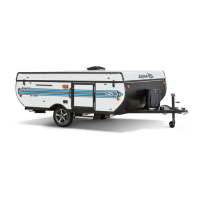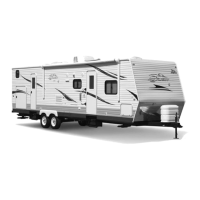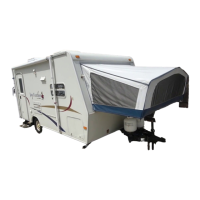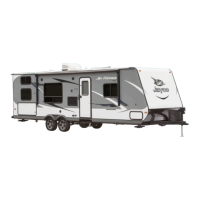indicate
when
the tank
is
filled
to
the
proper limit
by
appearance of
liquid replacing vapor.
At
ail
other times, the
overfill
valve
should
be
tightly
closed
by
hand
only.
The
main
valve
on
the
L.P.-gas
container should
be
tightened
by
hand
only using caution not to over-tighten. The valve
is
designed
to
satisfactorily close with only a reasonable amount of tightening.
Continua1 over-tightening
will
eventually
damage
the
valve
and
will
require
its replacement.
When
L.P.-gas
containers
are
filled to the proper level there is
available space for safe expansion
of
the
vaporized liquid. If
your
tank becomes overfilled
and
is
not allowed to "bleed
off"
before
installation with the
R.V.
system, it may gain pressure due to
exposure to
hot
sun
rays
and will begin "blowing off" pressure
from the relief
valve.
This can be detected
by
the strong odor
around tanks.
Keep
open flames away from this area. It
is
best
to
remove the bottle, take it to
a
safe area, and "bleed off" the
excess pressure
by
opening the valve
and
closing it when discharge
has been sufficient.
I-Iandje your L.P.-tanks with care.
Note that when disconnecting,
you must turn the wrench
in
a clockwise direction because the
connection utilizes
left
hand threads. When reconnecting, turn
wrench counter clockwise. When tightening,
only
"snug-up"
-
avoid
over-lightening. The tank must be in an upright position at
all times.
CAUTION:
If
you
have
double bottles
on
your
R.V.,
use only one
at
a
time. Otherwise the
gas
supply
will
be
drawn
eqdy from
both
bottles
unti
suppIy has
been totalEy exhausted.
Using
the
one
bottle
mtil
it
is
empty,
then
using
the
second bottle
will
allow
you
to
fill
the empty bottlte
at
yom convenience
without
being totally
out
of
propane.
If
you
travel alternately on wet roads and
in
freezing weather, be
sure your L.P.-gas regulator is protected
from
road spray.
If
water
enters the vent in the regulator it may freeze the pressure
controlling diaphragm
in
the open position to that the container
pressure
is
applied to the appliances
-
a
hazardous condition.
Follow
the
instructions given
by
the manufacturer
of
the regulator.
CAUTION:
Never smoke
daring
filling
of
L.P.-tanks.
Keep
the
R.V.
away
&om
immediate
Wing
area
when possible
or
extinguish
all
gas
pilot
lights.
When
a
L.P.-tank gets low, sometimes there is a concentration of
garlic-like odor which may
be
mistaken for a gas
leak.
After
a
changeover
to
a
full tank, the odor usually
will
soon
disappear.

